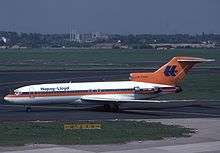Japan Airlines Flight 351
 The hijacked aircraft was later sold to Hapag-Lloyd Flug as D-AHLS. | |
| Hijacking | |
|---|---|
| Date | March 31, 1970 |
| Summary | Hijacking |
| Site | Japan |
| Aircraft type | Boeing 727-89 |
| Operator | Japan Airlines |
| Registration | JA8315 "YODOGO" |
| Flight origin | Tokyo International Airport (Haneda) |
| Destination | Fukuoka Airport |
| Passengers | 122 (excluding the hijackers) |
| Crew | 7 |
| Fatalities | 0 |
| Survivors | 129 (excluding the hijackers) |
Japan Airlines Flight 351 was hijacked by nine members of the Japanese Communist League-Red Army Faction (a predecessor of the Japanese Red Army) on March 31, 1970, while flying from Tokyo to Fukuoka, in an incident usually referred to in Japanese as the Yodogo Hijacking (よど号ハイジャック事件 Yodogō Haijakku Jiken).
Hijacking
Armed with samurai swords and pipe bombs,[1] the hijackers took 129 hostages (122 passengers and seven crew members), later releasing them at Fukuoka Airport and Seoul's Gimpo Airport (after an abortive attempt to disguise the airport as North Korean). They then proceeded to Pyongyang's Mirim Airport, with Japan's Transport Minister now as hostage, where they surrendered to North Korean authorities, who offered the whole group asylum. The hijackers' motive was to defect to North Korea.[2] Using North Korea as a base, they thought they could promote rebellion in South Korea and elsewhere across East Asia.
Later events
The alleged mastermind of the hijacking, who did not take part in the actual operation, was Takaya Shiomi. Shiomi was arrested, convicted, and served almost 20 years in prison in Japan. After his release in 1989,[3][4] suffering from poor health, Shiomi obtained a lowly paid[3] job as an attendant at a multi-level parking facility in Kiyose, Tokyo, where he was working as late as 2008.[5] He mentioned that they were supposed to go to Cuba in the first place.[1] He joined an antibase movement in Okinawa and an antinuclear campaign, and wrote several books related to the Red Army Faction.[4] In April 2015, he ran in the city assembly elections in Kiyose, campaigning on an anti-Abe platform and against the city's policies which are "bullying" the elderly.[3] He died on November 14, 2017 of heart failure at a Tokyo hospital.[4]
Moriaki Wakabayashi was an early member (bass player) in the long-running avant-garde rock band Les Rallizes Dénudés. In a March 2010 interview with Kyodo News, Wakabayashi stated that the hijacking was a "selfish and conceited" act. Wakabayashi added that he wished to return to Japan and was willing to face arrest and trial for his role in the hijacking.[6] In April 2014 he was still alive, and residing in North Korea together with other members of his group.[7]
In 1985, Yasuhiro Shibata returned to Japan in secret to raise money for the group, was arrested, and was sentenced to five years in prison. Yoshimi Tanaka was arrested in Thailand with a large amount of counterfeit money and repatriated to Japan in March 2000, where he was sentenced; he died before its completion. However, the other hijackers remain at large, according to Japan's National Police Agency.[8]
The leader of the group, Takamaro Tamiya, died in 1995 and Yoshida Kintaro sometime before 1985. Takeshi Okamoto and his wife Kimiko Fukudome were probably killed trying to flee North Korea.[9] Takahiro Konishi, Shiro Akagi, Kimihuro Uomoto and Moriaki Wakabayashi still reside in North Korea; all except Takeshi Okamoto were confirmed to have been alive as of 2004 when they were interviewed by Kyodo News. In June 2004, the remaining hijackers made a request to North Korean authorities that they be allowed to return to Japan, even if they are to be punished for the hijacking.[8]
Notable passengers
The future Roman Catholic Archbishop and Cardinal Stephen Fumio Hamao was one of the passengers on the flight. Japanese pop singer Mita Akira was also on the flight, as was Shigeaki Hinohara. Hinohara was one of the world's longest-serving physicians and educators.[10]
See also
References
- 1 2 Watts, Jonathan (September 9, 2002). "Japanese hijackers go home after 32 years on the run". The Guardian. London.
- ↑ 金日成 (1983). 統一戦線の理論と経験. チュチェ思想国際研究所. p. 29.
- 1 2 3 "Takaya Shiomi, former head of Sekigun-ha, up for election in Kiyose City assembly poll". April 19, 2015. Retrieved May 11, 2018.
- 1 2 3
- ↑ Botting, Geoff, "From terror to parking cars", Japan Times, May 11, 2008, p. 9.
- ↑ Kyodo News, "Ex-Red Army Faction Member Says Airplane Hijacking Was 'Selfish'", March 31, 2010.
- ↑ "The Yodogō Group's "Revolution Village" Today: Where the surviving Sekigun-ha Yodogō hijackers are living in North Korea". May 16, 2014. Retrieved May 11, 2018.
- 1 2 Movements of the Japanese Red Army and the "Yodo-go" Group" (PDF), Japan: National Police Agency, 2003, archived from the original (PDF) on March 23, 2011, retrieved March 15, 2007
- ↑ Steinhoff, Patricia, "Kidnapped Japanese in North Korea, The New Left Connection", Journal of Japanese Studies, 30 (1): 123–142, doi:10.1353/jjs.2004.0035 . The suspicious deaths of Kintaro and Okamoto are referred to on pages 136 and 137. Her research is based on the journalistic work of Takazawa Koji.
- ↑ Sugimoto, Hiroaki (August 8, 2013). "At 101, Japan's oldest clinician follows 70% rule for meals". The Asahi Shimbun. Tokyo. Archived from the original on May 17, 2015.